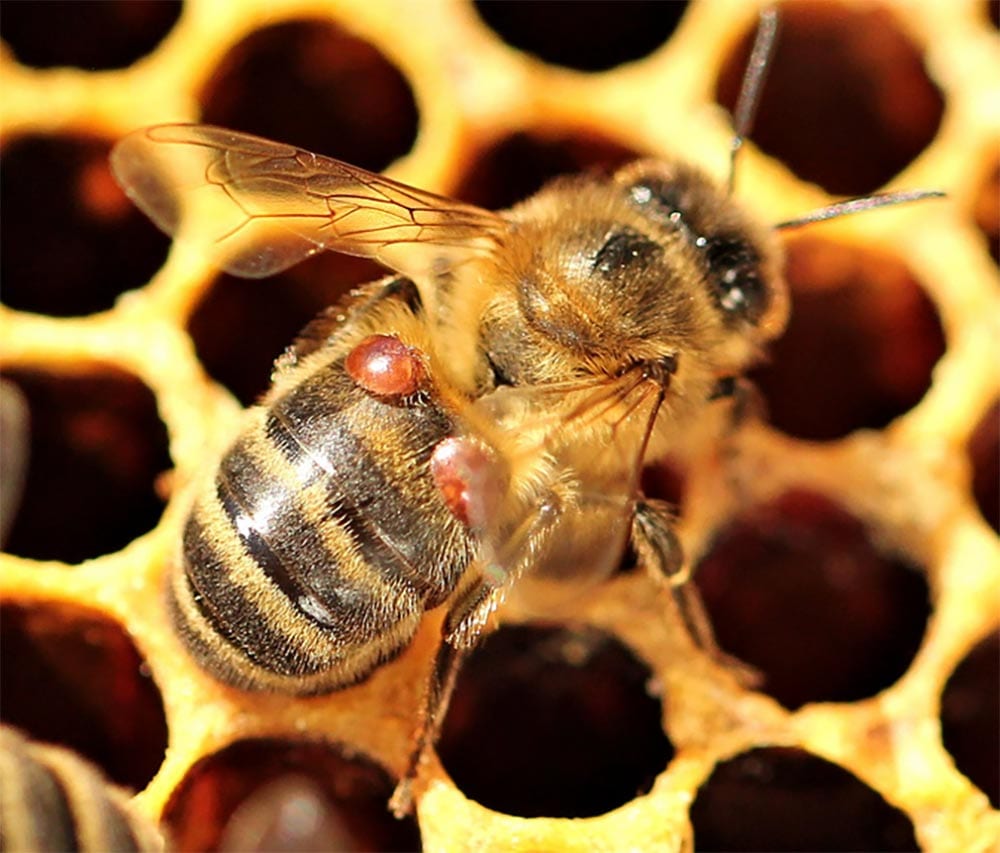
Some honeybee colonies adapt in wake of deadly mites

WORKER BEE WITH TWO VARROA MITES
A new genetics study of wild honeybees offers clues to how a population has adapted to a mite that has devastated bee colonies worldwide. The findings may aid beekeepers and bee breeders to prevent future honeybee declines.
The researchers genetically analyzed museum samples collected from wild honeybee colonies in 1977 and 2010; the bees came from Cornell University’s Arnot Forest. In comparing genomes from the two time periods, the results – published Aug. 6 in Nature Communications – show clear evidence that the wild honeybee colonies experienced a genetic bottleneck – a loss of genetic diversity – when the Varroa destructor mites killed most of the honeybee colonies. But some colonies survived, allowing the population to rebound.
“The study is a unique and powerful contribution to understanding how honeybees have been impacted by the introduction of Varroa destructor, and how, if left alone, they can evolve resistance to this deadly parasite,” said Thomas Seeley, the Horace White Professor in Biology at Cornell and the paper’s senior author. Sasha Mikheyev ’00, an assistant professor of ecology and evolution at Okinawa Institute of Science and Technology (OIST) in Japan, is the paper’s first author.”The paper is also a clear demonstration of the importance of museum collections, in this case the Cornell University Insect Collection, and the importance of wild places, such as Cornell’s Arnot Forest,” Seeley added.
In the 1970s, Seeley surveyed the population of wild colonies of honeybees (Apis mellifera) in Arnot Forest, and found 2.5 colonies per square mile. By the early 1990s, V. destructor mites had spread across the U.S. to New York state and were devastating bee colonies. The mites infest nursery cells in honeybee nests and feed on developing bees while also transferring virulent viruses.
A 2002 survey of Arnot Forest by Seeley revealed the same abundance of bee colonies as in the late 1970s, suggesting that either new colonies from beekeepers’ hives had repopulated the area, or that the existing population had undergone strong natural selection and came out with good resistance.
By 2010, advances in DNA technology, used previously to stitch together fragmented DNA from Neanderthal samples, gave Mikheyev, Seeley and colleagues the tools for whole-genome sequencing and comparing museum and modern specimens.
The results revealed a huge loss in diversity of mitochondrial genes, which are passed from one generation to the next only through the female lineage. This shows that the wild population of honeybees experienced a genetic bottleneck. Such bottlenecks arise when few individuals reproduce, reducing the gene pool. “Maybe only four or five queens survived and repopulated the forest,” Seeley said.
At the same time, the surviving bees show high genetic diversity in their nuclear genes, passed on by dying colonies that still managed to produce male bees. The nuclear DNA showed widespread genetic changes, a signature of adaptation. “Even when a colony is not doing well, it can still produce a batch of males, so nuclear genes were not lost,” Seeley said.
The data also show a lack of genes coming from outside populations, such as beekeepers’ bees.
The surviving bees evolved to be smaller, suggesting these bees might require less time to develop. Since the mites infest nursery cells in hives, the shorter development time may allow young bees to develop into adulthood before the mites can finish their development. Mite-resistant honeybees in Africa are also small and have short development times, Seeley said.
Next, the researchers will study which genes and traits confer resistance to Varroa mites. The findings may help beekeepers to avoid pesticides for controlling mites and to trust the process of natural selection, and bee breeders to develop bees with the traits that have enabled bees to survive in the wild.
General Questions About Honeybee Colonies
1. What makes organic honey different from regular honey?
Organic honey is produced without the use of synthetic pesticides, antibiotics, or genetically modified organisms (GMOs). Beekeepers follow strict organic standards set by certifying agencies, ensuring that their practices promote hive health and environmental sustainability.
2. How can I be sure that the honey I buy is truly local?
To ensure that honey is truly local, buy from farmers' markets, local beekeepers, or community-supported agriculture (CSA) programs. Look for labels that specify the region of production and ask questions about the sourcing and beekeeping practices to verify authenticity.
3. What are the benefits of consuming local honey for seasonal allergies?
Local honey may contain trace amounts of pollen from local plants, which some believe can help build immunity to local allergens and alleviate seasonal allergy symptoms. While scientific evidence is limited, many people find that consuming local honey helps reduce allergy symptoms.
4. How do organic beekeeping practices benefit the environment?
Organic beekeeping practices promote environmental stewardship by avoiding synthetic chemicals, supporting biodiversity, and enhancing the health of local ecosystems. Organic beekeepers often use natural methods to manage hives and pests, contributing to the sustainability of pollinator populations and their habitats.
5. What steps can beekeepers take to obtain organic certification for their honey?
Beekeepers can obtain organic certification by adhering to organic standards set by certifying agencies, such as the USDA National Organic Program. This includes using organic forage, avoiding synthetic chemicals, practicing integrated pest management, and maintaining detailed records of their practices. Certification requires regular inspections and compliance with these standards to ensure the honey meets organic criteria.
Read more at: http://phys.org/news/2015-08-honeybee-colonies-deadly-mites.html#jCp
Source: Some honeybee colonies adapt in wake of deadly mites



Leave a comment